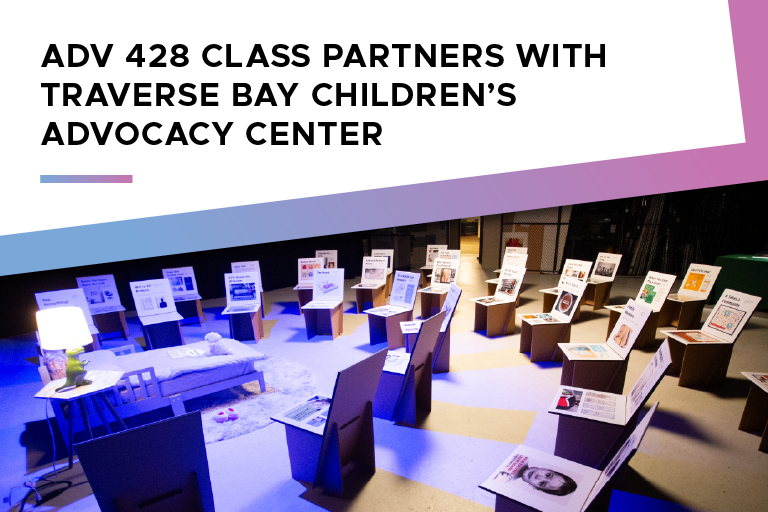Warning: This article mentions the topic of child sexual abuse.
On October 3, the College of Communication Arts and Sciences held an exhibition displaying a culmination of student work from a project featured in Professor of Practice Ross Chowles’s advanced advertising course (ADV 428).
The goal of the project: to imagine a world without abuse.
In collaboration with the Traverse Bay Children’s Advocacy Center (TBCAC), Chowles has developed a cornerstone project that asks his students to create an art-driven piece that educates community members about child sexual abuse (CSA) or helps shift social norms to prevent it. The exhibition features 30 pieces of student work from the past six years that incapsulate this message — one that Chowles seeks to create more awareness of.
Following the 2017 conviction of Larry Nassar, the former MSU physician and U.S. women’s national gymnastics team doctor who was convicted for the sexual assault of more than 100 minors, Chowles urged students to come up with what is now known as the #Go Teal Campaign. That led Chowles to a meeting with TBCAC, whom Michigan State University had recently sponsored as a demonstration site to test social norms. During the meeting, former TBCAC communications director Sue Bolde said to meeting participants, “Imagine a world without abuse.” It was there that Chowles decided he had to take this message to the classroom.
From there, the project has taken off and evolved to take on different messages.
“Some years the brief was about statistics,” said Chowles. “Ninety-two percent of survivors know their abuser. Then we did campaigns about noticing the red flags. We briefed the students to get families to talk about the topic. Then we asked them to urge communities to care for all the children, not just their own. Last year was about putting the safety of a child ahead of the reputation of an adult. This semester’s brief is to talk to men, as child sexual abuse is a male issue, and it’s time they start to own it.”
Throughout the six years that this course has taken place, students have wrestled with this topic and produced a number of works that aim to shift the social norms regarding child abuse. While students may opt out of the project due to the sensitive subject matter, Chowles says none of his 41 students from this semester have done so.
“Ross and his students' dedication to practicing the land grant mission philosophy is a primary example of what education is all about,” said Vice Provost for Faculty and Academic Staff Affairs Teresa Mastin.
With the aim of emphasizing the importance of the topic and highlighting the amazing work of his students, Chowles collected the six years of student work and displayed it for the students, faculty and university community members.
“I wanted the faculty to see what world class solutions the students can produce,” Chowles said. “Ninety-nine percent of what all students produce is invisible. It was time to shine a spotlight on them and their solutions…an exhibition is a very surreptitious way of engaging people in the topic. Because there are many solutions and angles, it’s a less confrontational way to communicate to people.”
“If there’s one thing we know about ‘Gen Z,’ it’s that they’re very driven by values,” said Dean Heidi Hennink-Kaminski. “They want to be a part of positive, meaningful change. This is especially important in the advertising and public relations field, where our students will lead careers sharing messages with large populations of people.”
Witnessing six years of work come to fruition has made Chowles especially proud, and he hopes that those who were able to witness it for themselves came to the realization that everyone plays a role in protecting children from sexual abuse.
“Stranger danger is a misnomer,” said Chowles. “It’s Uncle Bob or stepbrother Jim, it’s the priest or the coach that you need to worry about when it comes to protecting your child, or your communities’ children. We can imagine a world without abuse, but only if we confront its existence, rather than leave it in dark corner.”
By Casey Halas
